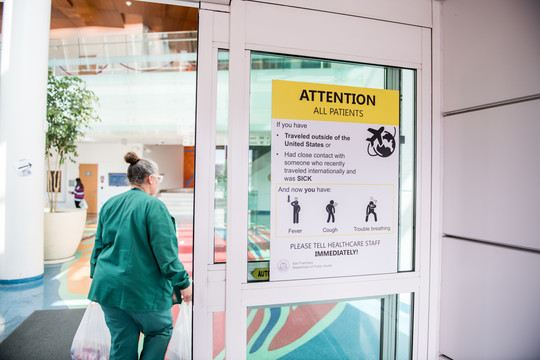Health care providers across the state also began to rely on telemedicine at unprecedented levels. Doctors at UCSF went from seeing 160 patients virtually a day to more than 2,000. In mid-March, physicians at Sutter Health’s 24 hospitals were seeing about 20-30 patients a day online; today that number is up to 6,000.
Medical leaders around the Bay Area jumped on Zoom calls discussing contingency plans for potential patient overflows.
“It was incredibly complicated and incredibly time-consuming,” said Dr. Adrienne Green, the chief medical officer at UCSF. “We have mostly done this as our day job since the beginning of February, when we had our first couple of patients here.”
Hospitals erected pop-up tents outside of main entrances to triage COVID-19 patients as they arrived, new mobile respiratory clinics came online to treat less serious coronavirus cases, and decommissioned floors at numerous facilities were reopened. Even bankrupt hospitals that were scheduled to close, like Seton Medical Center in Daly City, got a reprieve to care for patients. In San Diego, hospitals converted college dormitories to alternative care sites. In Los Angeles, a navy ship hospital anchored off the coast, and 3D printing was used to manufacture ventilator parts.
Currently the number of California COVID-19 patients requiring hospitalization continues to fall, and the number of patients in intensive care units has flattened.
But medical leaders say all the planning will pay off.
“We have now built in the muscle memory to be able to surge when needed,” says Dr. Stephen Lockhart, the chief medical officer for Sutter Health. UCSF’s Adrienne Green agrees. “We’re now ready and we have all the building blocks to be prepared for a resurgence if it happens.”
That includes not only a spike in coronavirus cases, but also California’s next devastating disaster like a deadly wildfire or an earthquake.
Hospital surge capacity is one of the six indicators Gov. Newsom is using to assess when and how to relax stay-at-home orders. The state has prepared 14 facilities with 2,072 beds statewide to accept patients. There are also more than 10,000 ventilators on hand that are not currently in use.
A report card the state issued recently also laid out progress made on procuring personal protective equipment and hospital beds for any surge. The state eased some restrictions last week instituted under its March stay-at-home order, allowing lower-risk nonessential businesses to open for the first time in nearly two months. Most Bay Area counties, however, are sticking with stricter guidelines for now. San Francisco and Marin county are considering opening some stores May 18.
